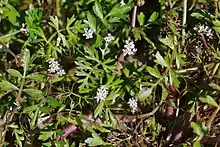| Apium | |
|---|---|
 | |
| Apium graveolens | |
| Scientific classification | |
| Kingdom: | Plantae |
| Clade: | Tracheophytes |
| Clade: | Angiosperms |
| Clade: | Eudicots |
| Clade: | Asterids |
| Order: | Apiales |
| Family: | Apiaceae |
| Subfamily: | Apioideae |
| Tribe: | Apieae |
| Genus: | Apium L. |
| Species | |
|
See text. | |
Apium (including celery and the marshworts) is a genus of about 20 species of flowering plants in the family Apiaceae, with a subcosmopolitan distribution in Europe, Asia, Africa, South America and Australia. They are medium to tall biennials or perennials growing up to 1 m high in the wet soil of marshes and salt marshes, and have pinnate to bipinnate leaves and small white flowers in compound umbels. Some species are edible, notably Apium graveolens, which includes the commercially important vegetables celery, celeriac and Chinese celery. Apium bermejoi from the island of Menorca is one of the rarest plants in Europe, with fewer than 100 individuals left.[1]
The genus is the type genus of the family Apiaceae and the order Apiales.
Species
As of January 2023, Plants of the World Online accepted the following species:[2]
- Apium annuum P.S.Short
- Apium australe Thouars
- Apium chilense Hook. & Arn.
- Apium commersonii DC.
- Apium fernandezianum Johow
- Apium graveolens L. - celery, wild celery[3]
- Apium insulare P.S.Short - Flinder's Island celery
- Apium larranagum M.Hiroe
- Apium panul (Bertero ex DC.) Reiche
- Apium prostratum Labill. ex Vent.
- Apium santiagoensis M.Hiroe
- Apium sellowianum H.Wolff
Species formerly placed in this genus include:
- Apium bermejoi → Helosciadium bermejoi
- Apium leptophyllum → Cyclospermum leptophyllum - marsh parsley, or fir-leafed celery
- Apium nodiflorum → Helosciadium nodiflorum - fool's water cress
- Apium repens → Helosciadium repens - creeping marshwort
Ecology
Apium species, including garden celery, are eaten by the larvae of some Lepidoptera species including angle shades, common swift, Hypercompe icasia, the nutmeg, setaceous Hebrew character and turnip moth.

References
- ↑ IUCN Red List: Apium bermejo.
- ↑ "Apium L." Plants of the World Online. Royal Botanic Gardens, Kew. Retrieved 2023-01-02.
- ↑ "Apium graveolens". FloraBase. Western Australian Government Department of Biodiversity, Conservation and Attractions.
External links